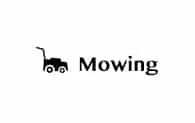The Art of Aeration: Why Your Lawn Needs It
Introduction
Aeration involves the infusion of air into a substance, typically soil or water, to improve its oxygen content. In agriculture, aeration enhances soil structure, allowing better root growth and nutrient absorption for healthier crops. In wastewater treatment, aeration promotes microbial activity, breaking down organic matter and purifying water. This oxygenation process is essential for maintaining ecological balance and ensuring the efficient functioning of various ecosystems and human activities. It is considered an art because it requires knowledge, timing, and technique to achieve the best results for your lawn.

Aspects of Aeration:
Aeration may not be the most glamorous aspect of lawn maintenance, but it is undoubtedly one of the most crucial. A lush, vibrant, and healthy lawn is a sight to behold. Achieving and maintaining such a lawn, however, is not a matter of luck or happenstance. It requires proper care and attention, and one of the most essential practices in lawn care is aeration.
Characteristics of Aeration:
The characteristics of aeration can vary depending on the application, but here are some general characteristics:
Oxygen Introduction:
Aeration primarily involves the introduction of oxygen into a medium. Oxygen is essential for various biological and chemical processes, and aeration helps ensure an adequate supply of oxygen for these processes.
Temperature Regulation:
Aeration can help regulate the temperature of a medium, especially in the context of wastewater treatment. The mixing action can help dissipate heat generated during biological processes.
Enhanced Microbial Activity:
Beneath the surface, a complex ecosystem of beneficial microorganisms exists. Aeration promotes microbial activity by providing them with the oxygen they need to break down organic matter and enrich the soil. This microbial action contributes to healthier soil and a more robust lawn.
Methods of Aeration
Core Aeration:
This is the most common method of aeration. It involves using a machine called a core aerator or lawn aerator to remove plugs or cores of soil from the ground. These cores are then left on the surface to break down naturally. Core aeration is best suited for larger lawns and gardens.
Spike Aeration:
Spike aerators use solid tines or spikes to poke holes into the soil without removing any cores. While this method is less invasive, it may not be as effective in relieving compaction compared to core aeration.
Best Time to aerate:
The best time to aerate your lawn or garden depends on the type of grass or plants you have and your climate. In general:
- For cool-season grasses (e.g., Kentucky bluegrass, fescue), early fall or early spring is ideal.
- If your soil is heavily compacted, aeration may be beneficial twice a year.
Aerating Your Garden or Lawn:
- Before aeration, mow your lawn to the desired height, and remove any debris or thatch.
- Decide whether to use a core aerator or spike aerator based on your specific needs and the size of your garden or lawn.
- After aeration, consider overseeding your lawn with grass seed and applying a layer of compost to enhance soil health and grass growth.
Tools and Equipment used for Aeration:
The tools and equipment used for aeration can vary depending on the specific application. There are many tools and equipment used for aeration some are as under:
Aeration Machines (Aerators):
- Lawn Aerators machines are used to aerate lawns and gardens. There are manual and powered versions, including plug aerators and spike aerators.
- Pond Aerators Used in ponds and water bodies to improve water quality and provide oxygen for fish and aquatic organisms.
Aeration Tools:
- Aeration Shoes are strapped onto your feet and have spikes or tines that penetrate the soil as you walk, aerating the lawn.
- Hand Aerators Handheld tools with tines or spikes that can be used to manually aerate small areas of soil.
- Soil Probe or Aeration Tube Used for aerating compacted soil in localized areas, often in gardening or landscaping.
Aeration Equipment for Wastewater Treatment:
- Aeration Tanks are large tanks used in wastewater treatment plants that use mechanical or diffused aeration systems to introduce oxygen into wastewater, facilitating the breakdown of organic matter by microorganisms.
- Diffusers and Aerators devices introduce air into the wastewater through fine bubbles, enhancing the biological treatment process.
- Aeration Blowers Provide the air supply for aeration systems in wastewater treatment facilities.
Aeration Equipment for Aquaculture:
- Aerator Pumps used in fish farming and aquaculture to oxygenate water in ponds or tanks to support aquatic life.
- Surface Aerators are Devices that agitate the water’s surface, allowing for oxygen exchange and preventing the formation of stagnant areas.
Why is aeration needed?
Some reasons why aeration is needed in various applications:
Water Treatment:
Aeration is essential in water treatment processes to add oxygen to water bodies, such as lakes, ponds, and wastewater treatment plants. Oxygenation supports aerobic biological processes that break down organic matter and pollutants, improving water quality.
Composting:
Aeration is essential in composting to facilitate the decomposition of organic matter. Turning or aerating compost piles allows oxygen to reach microorganisms responsible for breaking down organic materials into nutrient-rich compost. Turning or mixing compost piles introduces oxygen, which accelerates decomposition and prevents foul odors associated with anaerobic decomposition.
Better Nutrient Uptake:
Nutrients from fertilizers or organic matter applied to your lawn are only beneficial if they reach the root zone. Aeration facilitates the movement of nutrients into the soil, making them readily available to the grass.
Stress Relief:
High-traffic areas of your lawn can become compacted over time, leading to grass stress and reduced vitality. Aeration relieves this stress and prevents wear and tear from taking a toll on your lawn’s appearance.
How to do aeration lawn
While some homeowners choose to rent aerators and perform the task themselves, it’s often a job best left to professionals who have the equipment and expertise. A professional lawn care service can ensure the aeration process is done correctly, maximizing its benefits for your lawn.
“Our Company Ak Greenlife is providing all landscaping and hardscaping services to you in Reasonable prices”






